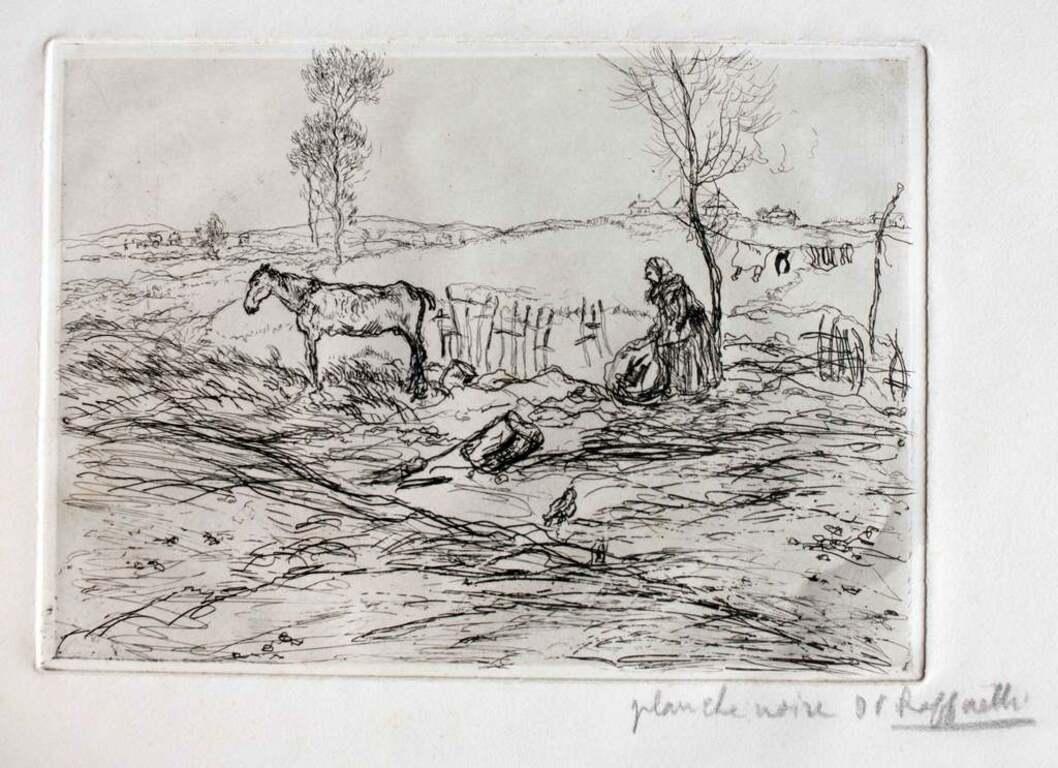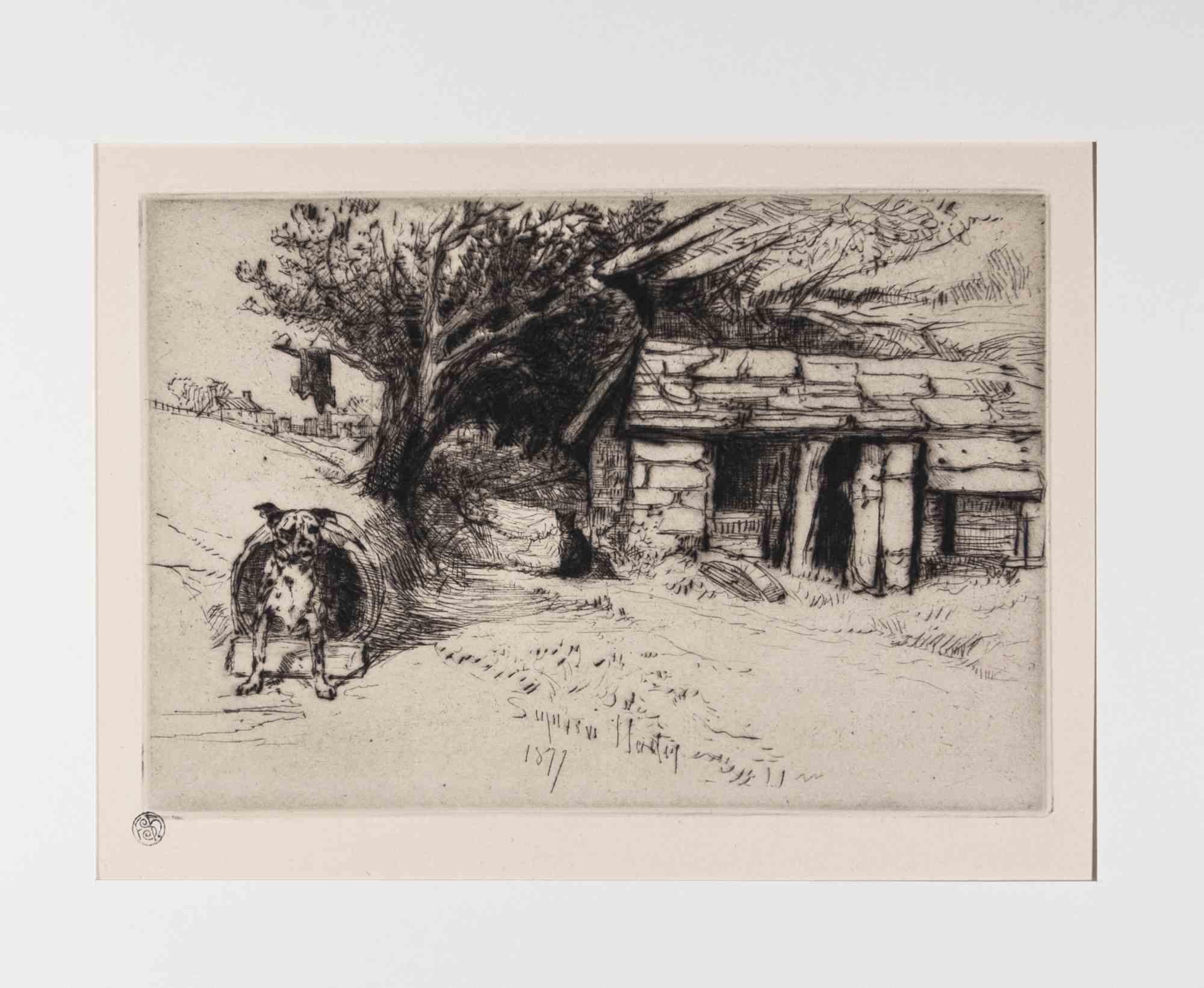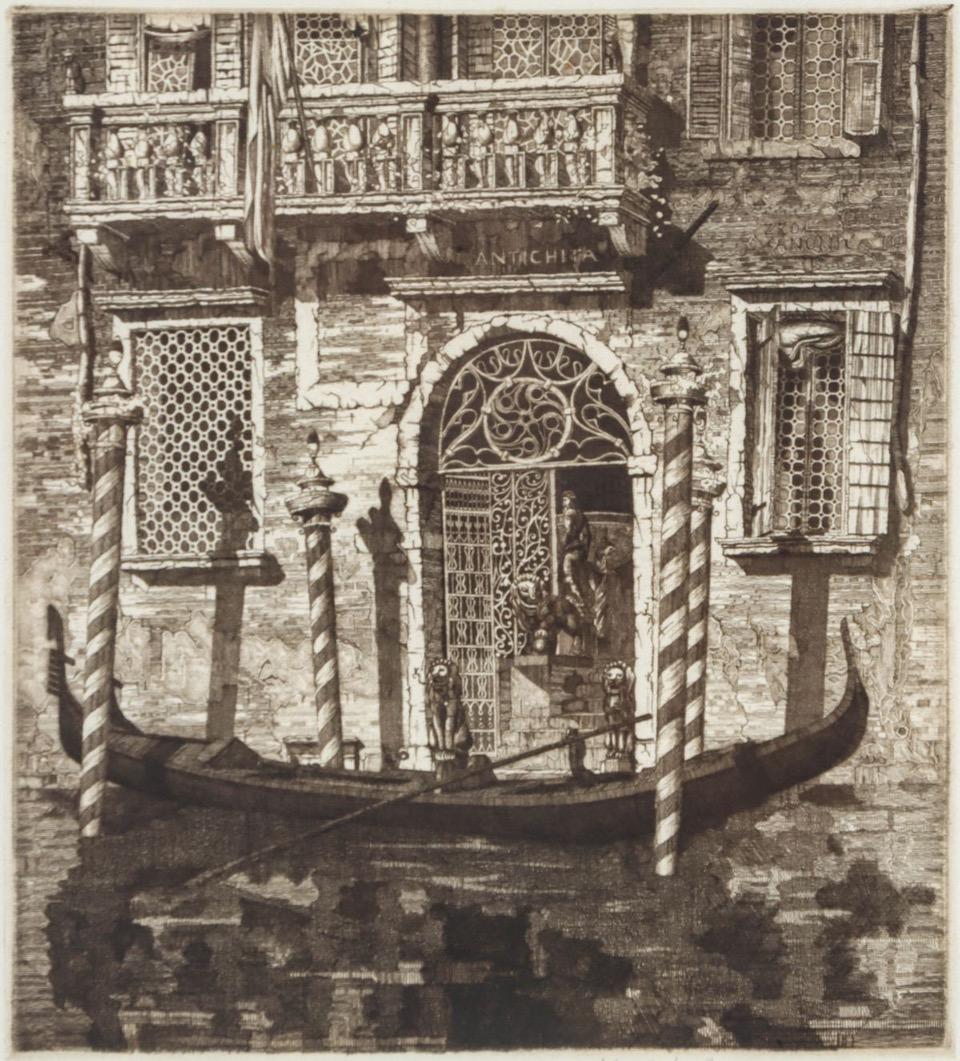Items Similar to Sotto Portico, Venice.
Want more images or videos?
Request additional images or videos from the seller
1 of 4
James McBeySotto Portico, Venice.1928
1928
About the Item
Sotto Portico, Venice. 1928. Etching. Hardie/Carter 235. 12 1/2 x 8 3/4 (sheet 8 1/4 x 11 3/8). Edition 80, #39. A rich impression printed in black/brown ink with subtle tonal wiping. Printed on antique French 1790 laid paper with full margins. Signed and numbered in ink.
The catalog describes the image: "At the Sotto Portico del Orso a man stands in a sandolo, holding by a ring on the wall. A girl is advancing in the shadow under the archway on his left.
.............................................................................................................
Born in Aberdeenshire, James McBey was a self-taught artist and etcher, best known for his prints, which coincided with an etching revival in the 20th century. After training himself in various techniques, in 1911 he gained an exhibition opportunity at the Goupil Gallery, in London. From this point on his prints were published in London and Glasgow, and during the First World War, McBey was appointed official war artist to the Palestine Expeditionary Force. McBey's work is held in a variety of galleries across the UK and beyond, with Aberdeen Art Gallery holding the vast majority.
- Creator:James McBey (1883 - 1959, British)
- Creation Year:1928
- Dimensions:Height: 12.5 in (31.75 cm)Width: 8.75 in (22.23 cm)Depth: 0.5 in (1.27 cm)
- Medium:
- Movement & Style:
- Period:
- Condition:
- Gallery Location:Storrs, CT
- Reference Number:1stDibs: LU335211298152
James McBey
Born in Aberdeenshire, James McBey was a self-taught artist and etcher, best known for his prints, which coincided with an etching revival in the 20th century. After training himself in various techniques, in 1911 he gained an exhibition opportunity at the Goupil Gallery, London. From this point on his prints were published in London and Glasgow. During the First World War McBey was appointed official war artist to the Palestine Expeditionary Force. McBey's work is held in a variety of galleries across the UK and beyond, with Aberdeen Art Gallery holding the vast majority.
About the Seller
5.0
Recognized Seller
These prestigious sellers are industry leaders and represent the highest echelon for item quality and design.
Platinum Seller
These expertly vetted sellers are 1stDibs' most experienced sellers and are rated highest by our customers.
Established in 1977
1stDibs seller since 2016
701 sales on 1stDibs
Typical response time: 1 hour
Associations
International Fine Print Dealers Association
- ShippingRetrieving quote...Ships From: Storrs, CT
- Return PolicyA return for this item may be initiated within 3 days of delivery.
More From This SellerView All
- La petite marine -- Souvenir de Medway. (Little Seascape, a Remembrance of the MBy Félix Hilaire BuhotLocated in Storrs, CTLa petite marine -- Souvenir de Medway. (Little Seascape, a Remembrance of the Medway). 1879. Etching, drypoint, false biting, aquatint, and stop-out. Bourcard-Goodfriend catalog 15...Category
1870s Modern Landscape Prints
MaterialsDrypoint, Etching, Aquatint
- Make Fast, Plate 2.By Arthur John Trevor BriscoeLocated in Storrs, CTMake Fast, plate 2. 1929. Etching. Laver catalog number 146; Hurst catalog number 258. Plate: 14 3/8 x 9 13/16 (sheet 17 5/8 x 11 3/4). Trial proof 2, before the edition or 75. Ill...Category
1920s Modern Landscape Prints
MaterialsDrypoint, Etching
- Under the BridgeBy Lawrence WilburLocated in Storrs, CTUnder the Bridge. 1985. Etching and drypoint. 9 1/2 x 12 1/8 (sheet 20 1/16 x 22). Edition 27, #13. Printed on cream wove paper, on the full sheet with deckle edges. A rich impression in excellent condition, housed in an archival folder. The etching has never been matted. Titled and numbered in pencil. by the artist; signed and initialed in pencil by the artist's estate. Provenance: the artist's estate A dramatic view of the lower East Side in New York. Housed in an archival folder awaiting your choice of mat and frame. Painter and printmaker Lawrence Nelson Wilbur...Category
20th Century American Modern Figurative Prints
MaterialsDrypoint, Etching
- The Gothic SpiritBy John Taylor ArmsLocated in Storrs, CTThe Gothic Spirit (also called A Gargoyle, A Gothic Spirit). 1922. Etching and stipple. Fletcher 120. 11 5/8 x 7 (sheet 15 1/4 x 11 1/4). Gargoyle Series #8. Edition 130. Illustrated...Category
1920s American Modern Landscape Prints
MaterialsDrypoint, Etching
- Guardians of the Spire (Amiens Cathedral Number 2)By John Taylor ArmsLocated in Storrs, CTGuardians of the Spire (Amiens Cathedral Number 2). 1921. Etching. Fletcher 102. 6 3/4 x 9 7/8 (sheet 8 7/8 x 13 3/4). Gargoyle Series #4. Edition 75. Illustrated: Dorothy Noyes Arms...Category
1920s American Modern Landscape Prints
MaterialsDrypoint, Etching
- Chelsea Old Church, LondonBy William Walcot R. E. Hon. R. I. B. A.Located in Storrs, CTChelsea Old Church. 1924. Etching, drypoint, and aquatint. Dickins 94. 5 3/8 x 8 (sheet 8 1/2 x 9 3/4). Edition 100 for The Print Collector's Club. A fine proof with tonal wiping, printed on cream wove paper. Signed and dedicated "W.R. Button from W. Walcot London 1930" in pencil. Chelsea Old Church, also known as All Saints, is an Anglican church, on Old Church Street, Chelsea, London SW3, England, near Albert Bridge. It is the church for a parish in the Diocese of London, part of the Church of England. Inside the Grade I listed building, there is seating for 400 people. There is a memorial plaque to the author Henry James (1843–1916) who lived nearby on Cheyne Walk. To the west of the church is a small public garden containing a sculpture by Sir Jacob Epstein. When he was seventeen,William Walcot began to study architecture under Louis Benois at the Imperial Academy of Art in Saint Petersburg. He went to Paris where he continued his studies at the Ecole des Beaux-Arts and the Atelier Redon. He practiced as an architect briefly in Moscow, designing the Hotel Metropole...Category
Early 20th Century Modern Landscape Prints
MaterialsDrypoint, Etching, Aquatint
You May Also Like
- French Village - Original Etching and Drypoint by Eugène Corneau - 1930sBy Eugene CorneauLocated in Roma, ITFrench Village is an original artwork realized by Eugène Corneau between the end of the 1920s and the beginning of the 1930s. The monogram of the artist is present on the lower left...Category
1930s Modern Figurative Prints
MaterialsEtching, Drypoint
- Untitled - Original Etching and Drypoint by Eugène Corneau - 1930sBy Eugene CorneauLocated in Roma, ITUntitled is an original artwork realized by Eugène Corneau in the first years of the 1930s. Etching and drypoint on paper. Monogram of the artist on the lower left. Excellent conditi...Category
1930s Modern Figurative Prints
MaterialsEtching, Drypoint
- Landscape - Etching by J. F. Raffaelli - Late 19th CenturyBy Jean-Francois RaffaelliLocated in Roma, ITEtching and drypoint. Hand signed. Very good condition.Category
Late 19th Century Modern Figurative Prints
MaterialsDrypoint, Etching
- The Cabin - Drypoint by Francis Saymour-Haden - 1877Located in Roma, ITThe Cabin is an original Modern artwork realized by Sir Francis Saymour-Haden (16 September 1818 – 1 June 1910) in 1877. Beautiful Proof on vélin fort, with stamp "Lugt 1048”. Full ...Category
1870s Modern Figurative Prints
MaterialsEtching, Drypoint
- Guardians of the Spire; Amiens Cathedral Number 2By John Taylor ArmsLocated in Middletown, NYGuardians of the Spire; Amiens Cathedral Number 2 New York: 1937. Etching and drypoint on watermarked F.J. Head cream-colored, antique laid paper, 6 3/4 ...Category
Mid-20th Century American Modern Figurative Prints
MaterialsEtching, Drypoint
- Palazzo dell'AngeloBy John Taylor ArmsLocated in Middletown, NYPalazzo dell'Angelo 1931 Etching and drypoint on cream-colored, handmade laid paper with deckle edges, 7 1/4 x 6 3/4 inches (185 x 171 mm), edition of 100, full margins. Signed, dated and numbered "Ed. 100" in pencil, lower margin, second state (of three). Printed by Henry Carling, New York. Extremely minor mat tone and some inky residue in the top right corner, all unobtrusive and well outside of image area. An exquisite impression of this intricate image, with astonishing detail, and all the fine lines printing clearly. The image represents the first print which Arms printed on his own handmade paper. Framed handsomely with archival materials and museum grade glass in a wood gilt frame with a flower and garland motif. Illustrated: Dorothy Noyes Arms, Hill Towns and Cities of Northern Italy, p. 180; Anderson, American Etchers Abroad 1880-1930; Eric Denker, Reflections & Undercurrents: Ernest Roth and Printmaking in Venice, 1900-1940, p. 116. [Fletcher 233] Born in 1887 in Washington DC, John Taylor Arms studied at Princeton University, and ultimately earned a degree in architecture at the Massachusetts Institute of Technology in 1912. With the outbreak of W.W.I, Arms served as an officer in the United States Navy, and it was during this time that he turned his focus to printmaking, having published his first etching in 1919. His first subjects were the Brooklyn Bridge, near the Navy Yard, and it was during his wartime travel that Arms created a series of extraordinarily detailed etchings based on Gothic cathedrals and churches he visited in France and Italy. He used what was available to him, namely sewing needles and a magnifying glass, to create the incredibly rich and fine detail that his etchings are known for. Upon his return to New York after the war, Arms enjoyed a successful career as a graphic artist, created a series of etchings of American cities, and published Handbook of Print Making and Print Makers (Macmillan, 1934). He served as President of the Society of American Graphic Artists, and in 1933, was made a full member of the National Academy of Design. In its most modern incarnation, Palazzo dell'Angelo was constructed in or around 1570. The building, which has a rich and storied history, was erected upon the ruins of an earlier structure which predates the Gothic period. Some remnants of the earliest features of the residence were most certainly still visible when Arms visited, as they are today. Having a background in architecture, there's no question that Arms was moved by the beauty, history and ingenuity represented in the physical structure. One thing specifically gives away Arms's passion for the architecture, and that is the fact that he focused on the building's Moorish entranceway, balustrade, and two mullioned windows, and not on the curious Gothic era bas-relief of an angel nestled into the facade of the building, after which the structure is named. The sculpture itself doesn't appear in Arms's composition at all, despite the fact that it is the feature of the building that is most famous in its folklore. Arms instead focuses on the oldest portion of the architecture, even documenting some of the remnants of a fresco, and a funerary stele for the freedman Tito Mestrio Logismo, and his wife Mestria Sperata (visible above the water level, to the left of the door, behind the gondola), which was first described in 1436. Among the many notable bits of history regarding the Palazzo, it has been documented that Tintoretto painted frescos of battle scenes on the facade of the building. The paintings have been lost to time and the elements, but not entirely to history. The empty frame...Category
1930s American Modern Figurative Prints
MaterialsEtching, Drypoint
Recently Viewed
View AllMore Ways To Browse
Venice Antique
Antique Print Of Venice
Glasgow Girls
Palestine Wall Art
French Portico
Aberdeen Antique
Antique Aberdeen
Antique Archway
James McBey. On Sale
Tiffany Trainers
Aviary Prints
Currier And Ives Lithograph
Kasimir Landscape Etchings
Sailboat Lithographs
Vintage Cremona
Wren Print
Balloon Etching
Christo Fabric




